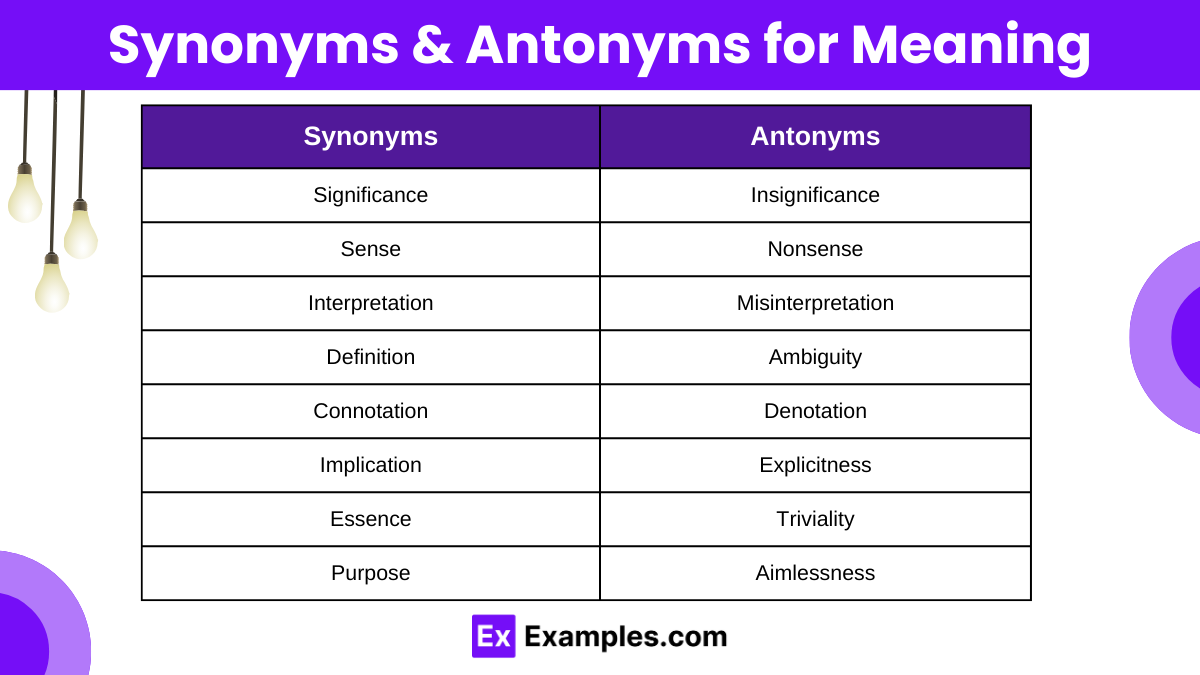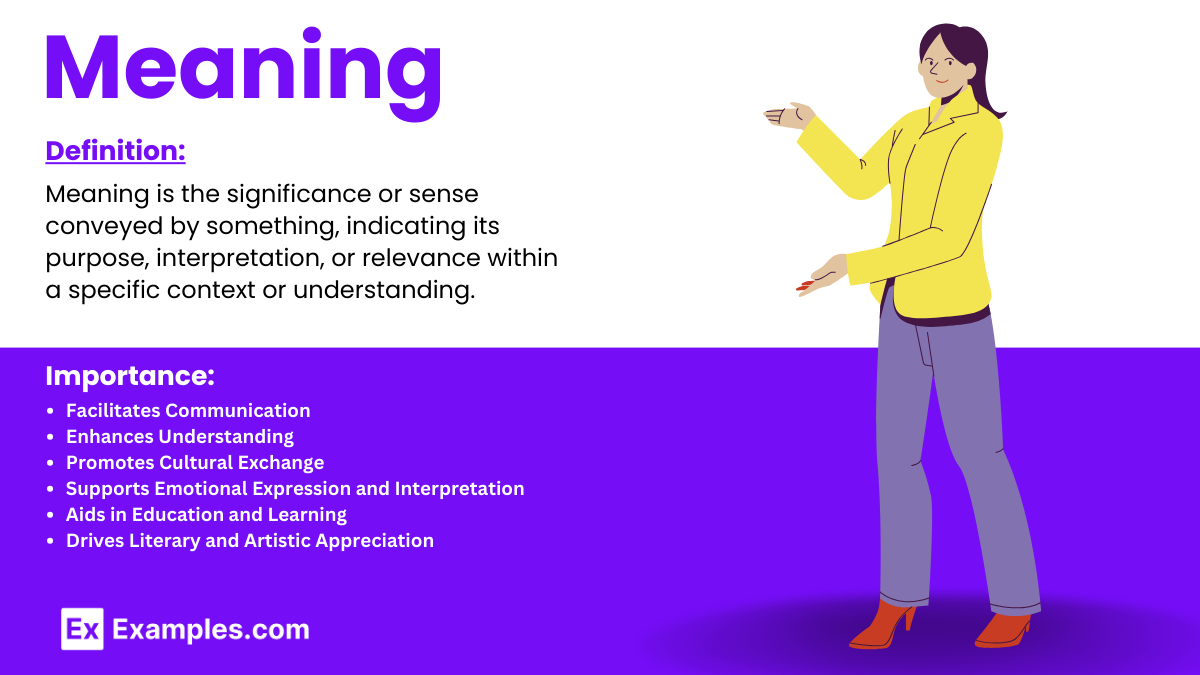20+ Meaning Examples
Meaning refers to the significance or interpretation of something, such as a word, action, or symbol. It is what individuals or cultures understand and perceive as the essence or purpose behind an object or concept. Meaning can vary depending on context, personal experiences, and cultural backgrounds, making it a fundamental concept in communication, philosophy, linguistics, and psychology, as it helps convey and decipher the intended messages and values in human interactions.
What is a Meaning?
Meaning refers to the significance or interpretation conveyed by words, actions, or symbols. It varies by context, culture, and personal perception, essential for communication and understanding in language.
How to Pronounce Meaning?
The word “meaning” is pronounced as /ˈmiː.nɪŋ/, which can be broken down into its phonetic components:
- The first syllable is pronounced with a long “ee” sound, represented phonetically as /miː/. This sounds like the word “me.“
- The second syllable begins with the “n” sound, followed by a short “i” sound, similar to the “i” in “bit,” and ends with the “ng” sound. This part is phonetically noted as /nɪŋ/.
Together, these sounds combine to form /ˈmiː.nɪŋ/, with the stress placed on the first syllable, making it slightly louder and longer than the second. This pronunciation is standard in both American and British English.
Importance of Meaning
Understanding the concept of meaning is fundamental in various aspects of human life, from daily interactions to complex communications and cultural expressions. Here are some of the key reasons why meaning holds significant importance:
1. Facilitates Communication
- Meaning is the core of language. It allows individuals to share ideas, emotions, and information effectively. Without a clear understanding of meaning, communication could easily become confusing and ineffective.
2. Enhances Understanding
- Comprehending the meaning of words, signs, and symbols enables us to understand the world around us. This understanding is crucial for learning, decision-making, and problem-solving.
3. Promotes Cultural Exchange
- Meaning plays a vital role in cultural identity and exchange. By understanding the meaning behind cultural symbols, rituals, and languages, individuals can appreciate and engage with diverse cultures more deeply.
4. Supports Emotional Expression and Interpretation
- Understanding the meaning of gestures, expressions, and tone of voice helps in interpreting others’ emotions and expressing our own. This is essential for building and maintaining personal and professional relationships.
5. Aids in Education and Learning
- In educational settings, the clarity of meaning in communication between educators and students is paramount. It ensures that knowledge is accurately conveyed and understood, facilitating effective learning and critical thinking.
6. Drives Literary and Artistic Appreciation
- In literature and the art, meaning enriches the audience’s experience and interpretation. Artists and writers use various techniques to layer meanings, offering deeper insights into their works.
7. Supports Legal and Scientific Precision
- In legal and scientific contexts, precision in meaning is essential. Misinterpretations can lead to significant consequences, highlighting the need for clear and unambiguous language.
Synonyms & Antonyms for Meaning

| Synonyms | Antonyms |
|---|---|
| Significance | Insignificance |
| Sense | Nonsense |
| Interpretation | Misinterpretation |
| Definition | Ambiguity |
| Connotation | Denotation |
| Implication | Explicitness |
| Essence | Triviality |
| Purpose | Aimlessness |
| Content | Void |
| Message | Silence |
Examples of “Meaning” in Sentences
Here are some examples of how the word “meaning” can be used in sentences, illustrating its various applications:
- The professor explained the meaning of the poem, highlighting its deeper themes and cultural significance.
- She searched for the meaning behind his cryptic words, unsure of his true intentions.
- Understanding the meaning of a legal contract is crucial before signing it to avoid potential misunderstandings.
- The documentary delved into the meaning of happiness, interviewing people from various walks of life.
- He gifted her a necklace that held a special meaning for both of them, symbolizing their years of friendship.
- In many cultures, colors carry specific meanings; for example, white often represents purity.
- The meaning of her gesture was clear, signaling her approval without a word.
- As he learned English, he frequently used a dictionary to grasp the meaning of new words.
- The debate team discussed the meaning of justice and how it applies in modern society.
- Finding meaning in one’s work can lead to greater job satisfaction and personal fulfillment.
Examples of “Meaning” in Poetry
The use of “meaning” in poetry is pivotal for expressing emotions, ideas, and deeper messages. Poets often layer their work with complex meanings to engage readers, provoke thought, and evoke feelings. Here are examples demonstrating how the concept of “meaning” manifests in poetry:
- Symbolic Meaning: Poets frequently use symbols like the rose or the raven to imbue their poetry with multiple layers of meaning. For example, a rose might represent both beauty and the pain of its thorns, symbolizing love’s dual nature.
- Cultural Meaning: Certain poems draw from cultural or historical contexts to add depth. Poems referencing mythological figures or historical events carry meanings that resonate with those familiar with the stories or history.
- Personal Meaning: Many poets infuse their work with personal experiences and emotions, which adds a unique and intimate layer of meaning. This can create a connection between the poet and the reader who may find personal significance in the shared experiences.
- Universal Meaning: Some poems tackle themes like death, love, or freedom, exploring meanings that are universal and resonate across different cultures and individual perspectives.
- Ambiguous Meaning: Poets often deliberately use ambiguous language to create open-ended interpretations. This encourages readers to explore multiple meanings based on their perspectives and experiences.
- Literal and Figurative Meaning: In poetry, words can function on both literal and figurative levels. A simple description of a sunset might carry the literal meaning of the sun setting but may also convey the figurative meaning of an ending or a farewell.
- Implied Meaning: Poets might imply meanings through what is left unsaid, relying on the reader’s imagination and inference to fill in the gaps, enhancing the poem’s emotional or thematic depth.
- Social and Political Meaning: Poetry can serve as a commentary on social or political issues, conveying meanings that criticize, question, or celebrate certain aspects of society.
- Spiritual and Philosophical Meaning: Some poems delve into spiritual or philosophical inquiries, using the poetic form to explore meanings related to existence, faith, and the human condition.
- Evocative Meaning: Through vivid imagery and careful word choice, poets evoke feelings and atmospheres, creating meanings that transcend the words on the page and stir the reader’s senses.
Examples of “Meaning” in literature
In literature, the concept of “meaning” is pivotal for enriching texts and engaging readers on multiple levels. Here are various examples from well-known literary works that illustrate how meaning is intricately woven into the fabric of storytelling:
- “Moby-Dick” by Herman Melville: The white whale, Moby Dick, is laden with multiple meanings, representing the unattainable, the unknowable, or nature’s indifference to man, depending on the reader’s interpretation.
- “The Road” by Cormac McCarthy: The journey of the father and son in this post-apocalyptic novel is rich with existential meaning, exploring themes of survival, the bond between parent and child, and what it means to be humane in a hostile world.
- “1984” by George Orwell: Orwell uses the concept of “Big Brother” and the oppressive regime to delve into the meaning of personal autonomy and freedom versus control and surveillance, providing a powerful commentary on totalitarian governments.
- “The Great Gatsby” by F. Scott Fitzgerald: The green light at the end of Daisy’s dock symbolizes Gatsby’s dreams and hopes, but also the broader American Dream and its pursuit, packed with layered meanings about societal aspirations and disillusionments.
- “To Kill a Mockingbird” by Harper Lee: Through the moral growth of Scout and the integrity of Atticus, the novel explores the meanings of justice, racism, and moral courage in a deeply segregated society.
- “Beloved” by Toni Morrison: This novel uses the ghost of Beloved as a symbolic medium to explore the meanings of slavery’s legacy, memory, and the unspoken traumas that haunt the characters.
- “Frankenstein” by Mary Shelley: Shelley’s creature embodies the meaning of humanity and monstrosity, questioning the ethics of creation and the responsibilities of the creator towards the created.
- “The Metamorphosis” by Franz Kafka: Gregor Samsa’s transformation into a giant insect serves as a powerful metaphor for alienation, identity, and the loss of humanity, offering deep existential and societal meanings.
- “Pride and Prejudice” by Jane Austen: Through the courtship between Darcy and Elizabeth, Austen explores the meanings of pride, prejudice, class, and the necessity of marrying for love versus financial security.
- “The Catcher in the Rye” by J.D. Salinger: Holden Caulfield’s disdain for the “phoniness” of the adult world explores the meaning of authenticity, the pain of growing up, and the struggle to preserve innocence in a cynical world.
What is your definition of Meaning?
Meaning refers to the significance, interpretation, or message conveyed by words, actions, symbols, or events, as understood in a particular context by an individual or within a cultural framework, influencing communication and perception.



